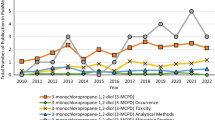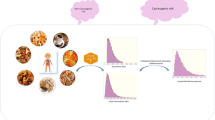Abstract
Soy sauces collected from the Korean market were determined for 3-monochloropropane-1,2-diol (3-MCPD) and daily intake of 3-MCPD through the consumption of soy sauce was estimated. Thirty-one samples were chosen based on a market share in 2017. The amount of 3-MCPD varied from not detected to 54.97 µg/kg with a mean value of 11.62 µg/kg. Seven soy sauces, which corresponded to 23% of the analysed samples, exceeded 20 µg/kg that is a maximum limit established by the Ministry of Food and Drug Safety in Korea. Daily intake of 3-MCPD was estimated as 1.22 ng/kg body weight (bw) for average consumers and 4.47 ng/kg bw for 95th high consumers, respectively. The exposure for average consumers amounted to 0.03–0.11% of the provisional maximum tolerable daily intake (PMTDI, 4 µg/kg bw). This indicates that the exposure to 3-MCPD from soy sauce is of low concern in the Korean population.

Similar content being viewed by others
References
ANZFA (Australia New Zealand Food Authority). Draft Assessment Proposal P243: Maximum limit for chloropropanols in soy and oyster sauces. Available from: https://www.foodstandards.gov.au/code/proposals/documents/P243%20DraftFAR.pdf. Accessed Mar. 2, 2020. (2001)
AOAC (The Association of Official Analytical Chemists). Guidelines for single laboratory validation of chemical methods for dietary supplements and botanicals. Available from: http://members.aoac.org/aoac_prod_imis/AOAC_Docs/StandardsDevelopment/SLV_Guidelines_Dietary_Supplements.pdf. Accessed Jan. 7, 2020. (2002a)
AOAC (The Association of Official Analytical Chemists). Official method for analysis of AOAC Intl. 17th ed. Method 2000.01. Association of Official Analytical Chemists, Arlington, VA, USA (2002b)
Arisseto AP, Vicente E, Eurlani RPZ, Toledo MCF. Estimate of dietary intake of chloropropanols (3-MCPD and 1,3-DCP) and health risk assessment. Food Sci. Technol. Int. 33(1):125–133 (2013)
Calta P, Velíšk J, Doležal M, Hasnip S, Crews C, Rébolvá Z. Formation of 3-chloropropane-1,2-diol in systems simulating processed foods. Eur. Food Res.Technol. 218: 501–506 (2004)
Chinese Ministry of Health. The Nutrition and Health condition for people in Chinese People. Available from: http://www.goldenrice.org/PDFs/China_nutr_rep_2004_en.pdf. Accessed Feb. 27, 2020. (2004)
Christova-Bagdassarian V, Tishkova JA, Vrabcheva TM. 3-Monochloro-1,2-propandiol (3-MCPD) in soy sauce from the Bulgarian market. Food Addit. Contam. Part B Surveill. 6: 163–167 (2013)
European Commission. Commission Regulation (EC) No 1881/2006 of 19 December 2006 setting maximum levels for certain contaminants in food stuffs. Available from: https://eur-lex.europa.eu/eli/reg/2006/1881/oj. Accessed Mar. 4, 2020. (2006)
European Commission. Commission Regulation (EC) No 333/2007 of 28 March 2007 laying down the methods of sampling and analysis for the official control of the levels of lead cadmium mercury inorganic tin 3-MCPD and benzo(a)pyrene in food stuffs. Available from: http://data.europa.eu/eli/reg/2007/333/oj. Accessed Mar. 4, 2020. (2007)
FAO (Food and Agriculture Organization of the United Nations). Code of practice for the reduction of 3-monochloropropane-1,2-diol (3-MCPD) during the production of acid-HVPs and products that contain acid-HVPs. Available from: https://www.semanticscholar.org/paper/CODE-OF-PRACTICE-FOR-THE-REDUCTION-OF-(3-MCPD)-THE/8f6dcff225334a01459462472aaa4d9ed1a01a36#paper-header. Accessed Aug. 3, 2020. (2008)
FDA (Food and Drug Administration). CDG Sec. 500.500 Guidance levels for 3-MCPD (3-chloro-1,2-propanediol) in acid-hydrolyzed protein and Asian-style sauces. Available from: https://www.fda.gov/regulatory-information/search-fda-guidance-documents/cpg-sec-500500-guidance-levels-3-mcpd3-chloro-1,2-propanediol-acid-hydrolyzed-protein-and-asian-style. Accessed Dec. 30, 2019. (2008)
Fu WS, Zhao Y, Zhang G, Zhang L, Li JG, Tang CD, Miao H, Ma JB, Zhang Q, Wu YN. Occurrence of chloropropanols in soy sauce and other foods in China between 2002 and 2004. Food Addit. Contam. 24: 812–819 (2007)
Genualdi S, Nyman P, DeJager L Simultaneous analysis of 3-MCPD and 1,3-DCP in Asian style sauces using QuEChERS extraction and gas chromatography-triple quadrupole mass spectrometry. J. Agric. Food Chem. 65: 981–985 (2017)
Hamlet CG, Sadd PA, Crews C, Velíšek J, Baxter DE. Occurrence of 3-chloro-propane-1,2-diol (3-MCPD) and related compounds in foods: a review. Food Addit. Contam. 19(7): 619–631 (2002)
Health Canada. Health Canada’s Maximum Levels for Chemical Contaminants in Foods. Available from: https://www.canada.ca/en/health-canada/services/food-nutrition/food-safety/chemical-contaminants/maximum-levels-chemical-contaminants-foods.html. Accessed Mar. 2, 2020. (2018)
IARC (The International Agency for Research on Cancer). IARC Monographs on the evaluation of carcinogenic risks to humans: Some chemicals present in industrial and consumer products food and drinking-water (3-Monochloro-12-propanediol). Available from: https://monographs.iarc.fr/wp-content/uploads/2018/06/mono101.pdf. Accessed Dec. 30, 2019. (2013)
JECFA (The Joint FAO/WHO Expert Committee on Food Additives). Evaluation of Certain Contaminants in Food: Eight-third report of the Joint FAO/WHO Expert Committee on Food Additives. WHO Technical Report Series 1002. Available from: https://apps.who.int/iris/bitstream/handle/10665/254893/9789241210027-eng.pdf?sequence=1&isAllowed=y. Accessed Dec. 30, 2019. (2017)
KAF & FTC (Korea Agro-Fisheries & Food Trade Corporation). Status of processed food segment market: Soy sauce. 2nd ed. KAF & FTC, Naju, Korea. pp. 64–73 (2018)
KHIDI (Korea Health Industry Development Institute). National food & nutrition statistics 2017: Based on 2017 Korea national health and nutrition examination survey. Available from: https://www.khidi.or.kr/kps/dhraStat/result10?menuId=MENU01663&year=2017. Accessed Jan. 6, 2020. (2019)
Kim E, Park S, Choi D. A sensitive analytical method for determination of 3-monochloropropane-1,2-diol and 1,3-dichloropropan-2-ol in various foods by gas chromatography with mass spectrometer. Anal. Sci. Technol. 21(6): 543–552 (2008)
Kim HJ, Ha JH, Chun HS, Cho EJ. Estimation of daily exposure to 3-monochloropropane-12-diol from commercial soy sauces in Korea. Food Sci. Biotechnol. 15: 768–772 (2006a)
Kim MG, Kim YS, Lee MJ, Kim JK, Kim KA, Park E, Ko H, Son J. Survey of contaminants of 3-MCPD and 1,3-DCP in soy sauce using GC/MSD. J. Food Hyg. Saf. 21: 153–158 (2006b)
Kobayashi M. Nutritional function of polysaccharides from soy sauce in the gastrointestinal tract. In: Bioactive food as dietary interventions for liver and gastrointestinal disease. Watson RR, Preedy VR (eds). Elsevier Inc., San Diego, CA, USA, pp 139–147 (2013)
KOCA (Korea Chain stores’ Association). The rank of sales in the yearbook of retail industry. 25th ed. Retail magazine, Seoul, Korea, pp. 682–685 (2017)
Lee BQ, Khor SM. 3-Chloropropane-1,2-diol (3-MCPD) in soy sauce: a review on the formation, reduction, and detection of this potential carcinogen. Compr. Rev. Food Sci. Food Saf. 14: 48–66 (2015)
Malaysia Food Act 1983 and Regulations 1985. Maximum permitted proportion of 3-monochloropropane-1,2-diol (3-MCPD) in specific food. Available from: http://fsq.moh.gov.my/v6/xs/page.php?id=72. Accessed Mar. 2, 2020. (2012)
MFDS (Ministry of Food and Drug Safety). Notification 2020-3 Available from: https://www.mfds.go.kr/brd/m_207/view.do?seq=14487. Accessed Feb. 10, 2020. (2020)
MFDS (Ministry of Food and Drug Safety). Risk assessment of 3-MCPD and 1,3-DCP in foods (11-1471057-01). National Institute of Food and Drug Safety Evaluation, pp. 47–61 (2019)
Nyman PJ, Diachenko GW, Perferri GA. Survey of chloropropanols in soy sauces and related products. Food Addit. Contam. 20: 909–915 (2003)
Vicente E, Arisseto AP, Furlani RPZ, Monteiro V, Goncalves LM, Pereira ALD, Toledo MCF. Levels of 3-monochloropropane-1,2-diol (3-MCPD) in selected processed foods from the Brazilian market. Food Res. Int. 77(3): 310–314 (2015)
WHO (World Health Organization). Global environment monitoring system-Food contamination monitoring and assessment programme (GEMS/FOOD). WHO, Geneva, Switzerland, pp. 52–53 (2002)
Wong KO, Cheng YH, Seah HL. 3-Monochloropropane-1,2-diol (3-MCPD) in soy sauce and oyster sauces: Occurrence and dietary intake assessment. Food Control. 17: 408–413 (2006)
Wong SF, Lee BQ, Low KH, Jenatabadi HS, Radzi CWJBWM, Khor SM. Estimation of the dietary intake and risk assessment of food carcinogens (3-MCPD and 1,3-DCP) in soy sauces by Monte Carlo simulation. Food Chem. 311: 126033 (2020)
Xu X, Ren Y, Wu P, Han J, Shen X. The simultaneous separation and determination of chloropropanols in soy sauce and other flavoring with gas chromatography-mass spectrometry in negative chemical and electron impact ionization modes. Food Addit. Contam. 23: 110–119 (2006)
Xu XM, Wu H, He HL, Huang BF, Han JL, Ren YP. Study of chloropropanols in soy sauce by gas chromatography-triple quadrupole mass spectrometry with coupled column separation without derivatisation. Food Addit. Contam. Part A 30(3): 421–429 (2013)
Acknowledgements
This work was supported by a sabbatical year (2019) and research grant (2019) from Seoul Women’s University.
Author information
Authors and Affiliations
Corresponding author
Ethics declarations
Conflict of interest
The authors declare that they have no conflict of interest.
Additional information
Publisher's Note
Springer Nature remains neutral with regard to jurisdictional claims in published maps and institutional affiliations.
Rights and permissions
About this article
Cite this article
Jang, Y., Koh, E. Assessment of estimated daily intake of 3-monochloropropane-1,2-diol from soy sauce in Korea. Food Sci Biotechnol 29, 1665–1673 (2020). https://doi.org/10.1007/s10068-020-00832-5
Received:
Revised:
Accepted:
Published:
Issue Date:
DOI: https://doi.org/10.1007/s10068-020-00832-5




